Book contents
- Frontmatter
- Contents
- Preface
- 1 Introduction
- 2 Historical survey
- 3 Instrumentation
- 4 Wave properties of electrons
- 5 The diffraction conditions
- 6 Geometrical features of the pattern
- 7 Kikuchi and resonance patterns
- 8 Real diffraction patterns
- 9 Electron scattering by atoms
- 10 Kinematic electron diffraction
- 11 Fourier components of the crystal potential
- 12 Dynamical theory – transfer matrix method
- 13 Dynamical theory – embedded R-matrix method
- 14 Dynamical theory – integral method
- 15 Structural analysis of crystal surfaces
- 16 Inelastic scattering in a crystal
- 17 Weakly disordered surfaces
- 18 Strongly disordered surfaces
- 19 RHEED intensity oscillations
- Appendix A: Fourier representations
- Appendix B: Green's functions
- Appendix C: Kirchhoff's diffraction theory
- Appendix D: A simple eigenvalue problem
- Appendix E: Waller and Hartree equation
- Appendix F: Optimization of dynamical calculation
- Appendix G: Scattering factor
- References
- Index
13 - Dynamical theory – embedded R-matrix method
Published online by Cambridge University Press: 06 July 2010
- Frontmatter
- Contents
- Preface
- 1 Introduction
- 2 Historical survey
- 3 Instrumentation
- 4 Wave properties of electrons
- 5 The diffraction conditions
- 6 Geometrical features of the pattern
- 7 Kikuchi and resonance patterns
- 8 Real diffraction patterns
- 9 Electron scattering by atoms
- 10 Kinematic electron diffraction
- 11 Fourier components of the crystal potential
- 12 Dynamical theory – transfer matrix method
- 13 Dynamical theory – embedded R-matrix method
- 14 Dynamical theory – integral method
- 15 Structural analysis of crystal surfaces
- 16 Inelastic scattering in a crystal
- 17 Weakly disordered surfaces
- 18 Strongly disordered surfaces
- 19 RHEED intensity oscillations
- Appendix A: Fourier representations
- Appendix B: Green's functions
- Appendix C: Kirchhoff's diffraction theory
- Appendix D: A simple eigenvalue problem
- Appendix E: Waller and Hartree equation
- Appendix F: Optimization of dynamical calculation
- Appendix G: Scattering factor
- References
- Index
Summary
Introduction
The embedded R-matrix method formulated by Tong's group (Tong et al., 1988a, b; Zhao et al., 1988), like Ichimiya's matrix method, seeks to manipulate the differential form of the Schrödinger equation. It is also a multi-slice method, in which the crystal is modelled as a slab divided into many thin slices parallel to the surface. The wave inside the crystalline slice is decomposed into a set of beams by making use of the perfect translational symmetry parallel to the surface, and the Schrödinger equation is then solved. To determine the RHEED intensity, the wave transmitted out of the bottom of the slab is sequentially matched to the wave functions found for each slice until it can be matched to the incident and reflected components of the wave at the surface, allowing the reflection coefficient to be calculated. The key feature of the method is in the procedure for connecting the ratio of the wave function and its first derivative at the interface between each slice. The method relies on the computation of this ratio using a simple recursion that only manipulates N × N matrices. Tong and coworkers argued that this ratio, a generalized logarithmic derivative, is fundamentally well behaved, lessening the numerical convergence problems associated with all these computational schemes.
Like the other methods that make use of the translational symmetry parallel to the surface, this method decomposes the wave function and the crystal potential into their Fourier components or “beams.”
- Type
- Chapter
- Information
- Reflection High-Energy Electron Diffraction , pp. 173 - 191Publisher: Cambridge University PressPrint publication year: 2004

